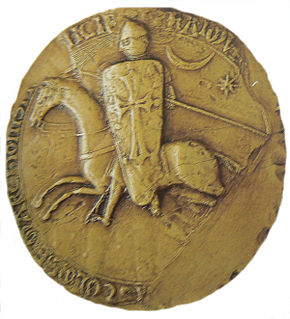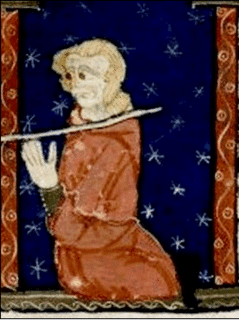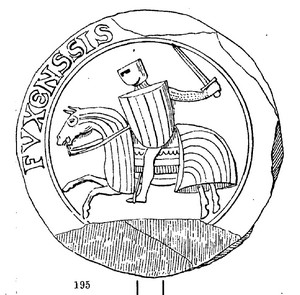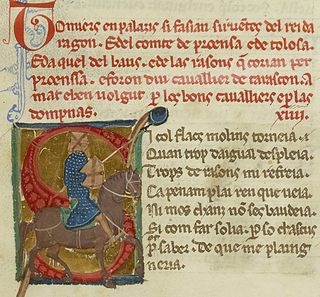
The Albigensian Crusade or the Cathar Crusade was a 20-year military campaign initiated by Pope Innocent III to eliminate Catharism in Languedoc, in southern France. The Crusade was prosecuted primarily by the French crown and promptly took on a political aspect, resulting in not only a significant reduction in the number of practising Cathars, but also a realignment of the County of Toulouse in Languedoc, bringing it into the sphere of the French crown, and diminishing both Languedoc's distinct regional culture and the influence of the counts of Barcelona.

The Trencavel was an important noble family in Languedoc between the 10th and 13th centuries. The name "Trencavel" began as a nickname and later became the family surname. The name may derive from the Occitan words for "Nutcracker". The name was traditionally restricted in actual use only to those family members named Raymond, but the last Trencavel viscount, Raymond II, preferred the surname over his given name and adopted it for his charters.

Raymond VI was Count of Toulouse and Marquis of Provence from 1194 to 1222. He was also Count of Melgueil from 1173 to 1190.

Raymond VII was Count of Toulouse, Duke of Narbonne and Marquis of Provence from 1222 until his death.
Raymond Roger Trencavel was a member of the noble Trencavel family. He was viscount of Béziers and Albi, and viscount of Carcassonne and the Razès.

Peire Cardenal was a troubadour known for his satirical sirventes and his dislike of the clergy. Ninety-six pieces of his remain, a number rarely matched by other poets of the age.

Roger Bernard II, called the Great, was the seventh count of Foix from 1223 until his death. He was the son and successor of the count Raymond-Roger and his wife Philippa of Montcada.

Raimon de Miraval(h) was a troubadour and, according to his vida, "a poor knight from Carcassonne who owned less than a quarter of the castle of Miraval." Favoured by Raymond VI of Toulouse, he was also later associated with Peter II of Aragon and Alfonso VIII of Castile. His senhal for Raymond VI was Audiart.
Esclarmonde of Foix, was a prominent figure associated with Catharism in thirteenth century Occitania.
Roger II Trencavel was the Viscount of Carcassonne, Béziers, Razès, and Albi from 1167 or 1171 until his death. Until 1177 he used the title proconsul, usually as proconsul de Bitteris, but he abandoned the usage when he became a vassal of the Crown of Aragon. His government of his lands was characterised by increasing complexity, such as the development of the offices of seneschal and sub-vicar, but his later years are characterised by financial troubles and a "general malaise" perhaps brought about by his poor relations with the Church hierarchy in light of his favourable attitude towards Catharism.

Cadenet was a Provençal troubadour (trobador) who lived and wrote at the court of Raymond VI of Toulouse and eventually made a reputation in Spain. Of his twenty-five surviving songs, twenty-one are cansos, with one alba, one partimen, one pastorela, and one religious piece represented. Two of his melodies survive.

Guillem or Guilhem Figueira or Figera was a Languedocian jongleur and troubadour from Toulouse active at the court of the Emperor Frederick II in the 1230s. He was a close associate of both Aimery de Pégulhan and Guillem Augier Novella.

Tomier and Palaizi were two knights and troubadours from Tarascon, possibly brothers, and frequent comrades and co-composers.

Raymond II Trencavel was the last ruler of the branch of the Trencavel viscounts of Béziers. His entire life was occupied by efforts to reverse the downfall the Trencavel had experienced during the Albigensian Crusade, but he ultimately failed.
Raymond I Trencavel was the Viscount of Agde and Béziers from 1130 and Viscount of Albi, Carcassonne, and Razès from 1150. He was a member of the Trencavel family, ruling the lands of the elder branch.
Roger I Trencavel,, was the eldest son of Bernard Ato IV, Viscount of Albi, Agde, Béziers, Carcassonne, Nîmes, and Razès. On his father's death in 1130 he inherited Albi, Carcassonne, and Razès, while his younger brother Raymond inherited Agde and Béziers and his youngest brother Bernard Ato V inherited Nîmes.
Bernard Ato VI was the posthumous son and successor of Bernard Ato V, Viscount of Nîmes and Agde. He reigned from 1163 until 1214, when he surrendered his fiefs to Simon de Montfort, Earl of Leicester and leader of the Albigensian Crusade. Bernard Ato was not connected with Catharism nor were his lands, but his relationship to Raymond Roger Trencavel may have marked him off as an enemy of the Crusade by default, for he was a Trencavel, though he did not carry that name.
The Liber instrumentorum vicecomitalium, sometimes called the Trencavel Cartulary (CT) or Cartulaire de Foix, is a high medieval cartulary commissioned by the Trencavel family. It preserves either 585 or 616–7 charters, the earliest of which dates to 1028 and the latest to 1214. The charters preserve a record of important feudal customs relating to the lands of the Trencavel, namely Albi, Agde, Béziers, Carcassonne, Nîmes, and Razès, all of which—save Carcassonne, which was a county—were viscounties, hence the cartulary's name. It is preserved in a twelfth-century manuscript, now kept with the Société Archéologique de Montpellier, where it is MS 10.

AimeryIII, known in Spanish as Aimerico Pérez de Lara, was the Viscount of Narbonne from 1194 until his own death. He was a member of the House of Lara. Throughout his reign he had to navigate competing claims of suzerainty over him and until 1223 his reign was dominated by the Occitan War. He participated unenthusiastically on the side of the crusaders, but retained his viscounty, which he passed on to his son.
Pierre Roger de Cabaret (French) or Pèire Rogièr de Cabaret (Occitan) was a military leader of the Occitan forces in the Albigensian Crusade.












